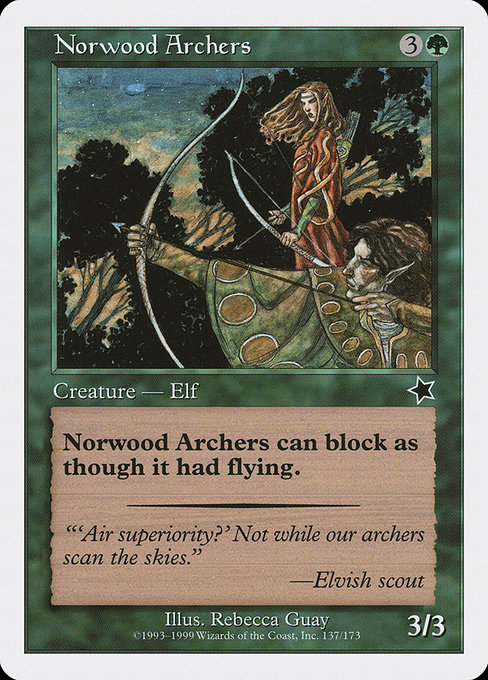
Image courtesy of Scryfall.com
Design Lessons from a Classic Green Creature
When you crack open a Starter 1999 deck and see Norwood Archers eyeing the skies, you’re looking at more than a simple two-tone creature—it’s a compact tutorial in green’s design philosophy. This common Elf Archer comes with a modest 3/3 body for four mana a basic, sturdy benchmarking figure in a color that prizes reach, defense, and natural resilience. The mana cost of {3}{G} situates the card squarely in the midgame, offering a reliable play that can anchor a green ramp or be a dependable roadside defender in accelerated starts. The card’s survivability and utility are quiet reminders that not every legendary, flashy Mythic needs to be the star of the show to leave a lasting impression 🧙♂️🔥.
From a designer’s lens, this card demonstrates how color identity should resemble a toolkit, not a gimmick. Green’s strength isn’t just big numbers; it’s a philosophy of ecosystem-building—creatures that scale with the board, reach that defends against aerial threats, and a flavor that ties the forest to the battlefield. Norwood Archers’ reach keyword—“This creature can block creatures with flying”—embeds a defensive lane into the green identity. It’s not flashy, but it’s essential: a targeted answer to a foe’s air tempo, a way to keep ground strategies relevant, and a reminder that a single keyword can shape matchup arcs for entire games. Designers learn to balance the cost with the expected impact, and this card nails that balance without resorting to gimmicks 🎨⚔️.
- Clear mechanical identity: Green’s strength is about natural resilience and grounded defense. The Archers illustrate how a color’s toolkit can reliably counter flying threats without stepping outside the expected power curve.
- Power, cost, and timing: A 3/3 for four mana with reach is a graceful, predictable tempo play. It rewards board presence and punishes over-committing to air strategies, while still remaining approachable for new players stepping into the game.
- Rarity and accessibility: As a common from Starter 1999, its availability helps new players build confident boards without feeling overwhelmed by rarities or power spikes. Accessibility is a design feature in its own right 🧙♂️.
- Flavor and function entwined: The flavor text—“Air superiority? Not while our archers scan the skies.”—cements a world in which Elven scouts defend their forests through vigilant archery, enriching both lore and play feel.
- Reprint value and longevity: The card’s recurring presence in later printings keeps the archetype accessible and familiar, a gentle reminder that good design endures beyond a single set.
Air superiority? Not while our archers scan the skies. —Elvish scout
In practical design terms, Norwood Archers embodies how a seemingly modest card can carry weight through consistency and context. It grounds green in a specific defensive role, gives players a reliable line of play, and rewards patient development rather than explosive play patterns. The art by Rebecca Guay—an evocative forest tableau—complements the mechanics, turning a simple stat line into a narrative moment on the battlefield. It’s a reminder that elegance in card design often rests in restraint and clarity, not in flashy tricks or outlandish combos. And yes, even a Starter-era common can spark a lot of strategic thinking and nostalgia 🧙♂️💎.
For modern designers, the lesson is transferable: anchor a color’s identity with dependable interactions, give creatures a meaningful but safe stat line, and weave flavor into utility so players feel the world behind the card. Norwood Archers shows that a creature doesn’t need to be a powerhouse to be memorable—sometimes the quiet, sturdy pieces do the most heavy lifting when the board grows crowded with threats and possibilities 🎲.
On the content side, crafting deck experiences around early greens like this encourages fresh players to experiment with defensive tactics and mix in subtle synergies. The card’s evergreen nature invites players to discover new lineages of green strategies, from traditional forest-based tempo to more modern, value-driven builds. And in a hobby where collectors appreciate both variance and cohesion, a card that remains relevant across printings can become a touchstone for a whole generation of fans who grew up with the forest as their home base 🔥.
As you explore the deeper craft of MTG design, you can pair your study with practical tools for daily play, travel, or content creation. For example, a sturdy phone grip with a kickstand is a small but mighty companion when you’re studying card galleries, filming quick strategy clips, or just keeping a live board view steady while you narrate a match. It’s a tiny convenience that mirrors the big ideas behind a card like Norwood Archers—solid, reliable, and always ready to help you defend your forested frontier 🧙♂️🎨.
Curious about more content across related domains? The network below offers a mix of science, gaming, and brand strategy that aligns with the thoughtful, methodical mindset designers bring to MTG. Read on to deepen your understanding of data interpretation, cryptocurrency implications for gaming, and best practices for transparent branding in the digital age 🔥💎.
Phone Click On Grip Durable Polycarbonate KickstandMore from our network
- https://transparent-paper.shop/blog/post/precise-astrometric-data-refine-milky-way-models-from-a-blue-hot-beacon/
- https://crypto-acolytes.xyz/blog/category/cryptocurrency/
- https://crypto-acolytes.xyz/blog/post/crypto-taxes-on-gaming-earnings-a-practical-guide/
- https://crypto-acolytes.xyz/blog/post/beginners-guide-to-setting-up-minecraft-forge/
- https://blog.digital-vault.xyz/blog/post/unlocking-consumer-trust-through-transparent-branding/